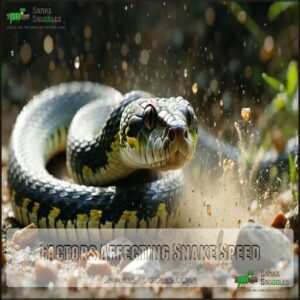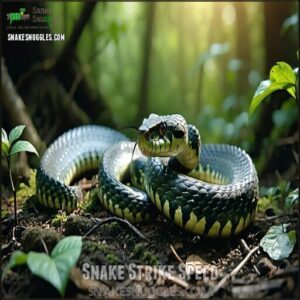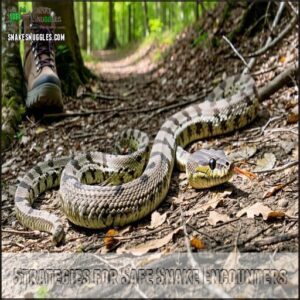This site is supported by our readers. We may earn a commission, at no cost to you, if you purchase through links.

Most snakes clock in at around 3-5 mph (5-8 km/h) when moving across flat ground, but some species are speed demons.
The black mamba, for example, can hit impressive speeds of up to 12.5 mph (20 km/h).
Sidewinders, known for their unique diagonal movement, can move even faster on sandy terrain.
Snake speed depends on the species, terrain, and motivation—whether they’re chasing prey or escaping danger.
Luckily, they’re not marathon runners, so you’d likely outrun most snakes in a straight race.
Curious? Let’s untangle some more thrilling records and explore how snakes can be quite fast.
Table Of Contents
- Key Takeaways
- Snake Speed Records
- Factors Affecting Snake Speed
- Snake Strike Speed
- Fastest Moving Snakes
- Human Vs. Snake Speed
- Frequently Asked Questions (FAQs)
- Do snakes slither faster than humans?
- How fast do snakes slither?
- How do snakes slither?
- How fast can a horned rattlesnake Slither?
- How fast can a sidewinder snake move?
- How fast can a black snake run?
- How Does a Snake’s Age Affect Its Speed?
- How Do Snakes Accelerate and Slow Down When Moving?
- How quickly does a snake move?
- Can we outrun a snake?
- Conclusion
Key Takeaways
- Most snakes slither at 3-5 mph, but speedsters like the sidewinder can hit 18 mph on sand, adapting to their environment with unique movement.
- Speed varies by species and terrain, with black mambas reaching up to 12.5 mph and king cobras up to 15 mph on land.
- Snakes strike faster than they move, with some like the Eastern brown snake striking at 3.4 m/s, far beyond human reaction time.
- You can outrun most snakes since their top speeds are brief, and they tire quickly, especially on non-ideal terrain like pavement.
Snake Speed Records
In terms of speed, some snakes are surprisingly quick, reaching up to 18 miles per hour.
You won’t see these record holders in a footrace, but their impressive velocity helps them hunt or escape danger in their unique environments, utilizing their speed to hunt or escape.
Sidewinder: Up to 18 Mph (29 Km/h)
The sidewinder snake isn’t just the fastest snake—it’s the desert’s most impressive speed demon, reaching up to 18 mph. It zips across dunes like a living spiral, turning the hostile terrain into its personal racetrack. Thanks to sidewinding efficiency, this unique form of snake locomotion reduces friction, helping it move effortlessly on shifting sand.
The sidewinder transforms desert dunes into a racetrack, sidewinding at 18 mph with unmatched agility and frictionless grace.
With its desert adaptation, the sidewinder’s scales act like heat shields, allowing it to slither comfortably on sizzling surfaces. It’s also a predator with precision, using its speed to snag unsuspecting prey as part of its sidewinder diet.
- Zips over scorching sand like a pro.
- Combines speed with pinpoint accuracy as a predator.
- Its evolution showcases nature’s ingenuity.
Black Mamba: Up to 12.5 Mph (20 Km/h)
The Black Mamba isn’t just fast—it’s a speed demon of the snake world, capable of slithering up to 12.5 mph.
Found across Africa’s savannas and rocky terrain, this agile predator uses its incredible snake locomotion to hunt small mammals and birds or escape threats with ease.
Its Mamba Venom is famously potent, but it prefers to avoid conflict.
| Mamba Speed Facts | Details |
|---|---|
| Top Speed | Up to 12.5 mph (20 km/h) |
| Habitat | African savannas, rocky hills |
| Diet | Small mammals, birds |
| Behavior | Skittish, avoids humans when possible |
Eastern Brown Snake: Up to 12.5 Mph (20 Km/h)
At an impressive 12.5 mph, the Eastern Brown Snake blends extreme venom potency with agility, making it a survival expert.
Its snake slithering speed guarantees explosive escapes and lightning-fast strikes.
Adapted to diverse habitats, this fastest snake thrives in Australia’s wild terrain, managing rodent populations.
Mastering snake locomotion, it balances precision and power—a true icon of snake movement and resilience.
Southern Black Racer: Up to 9.94 Mph (16 Km/h)
The Southern black racer is a master of speed, reaching up to 9.94 mph (16 km/h).
This non-venomous snake shines with its agility. Picture it:
- Racer habitat: Lush forests or sunny fields.
- Racer diet: Frogs, insects, and rodents.
- Racer behavior: Quick to flee, faster to hunt.
- Snake slithering speed: Lightning-like.
- Racer conservation: Key predator maintaining balance.
While impressive, humans can achieve faster speeds, especially with enhanced fitness routines.
King Cobra: Up to 15 Mph (24 Km/h)
The King Cobra isn’t just one of the deadliest snakes—it’s also one of the fastest.
Reaching up to 15 mph, this speedy predator uses its streamlined body and incredible snake locomotion to slither swiftly through Southeast Asia’s dense forests.
Known for their precision, King Cobras rely on their snake slithering speed and smart hunting tactics to stalk prey or escape danger.
Unlike its slower relative, the black mamba, the King Cobra adapts to its habitat range while maintaining its reputation as a conservation priority and an agile contender.
Factors Affecting Snake Speed
In terms of snake speed, a lot depends on their size, body shape, and the way they move.
You’d be surprised how much their environment and even their hunting style can shift their pace!
Body Size and Length
In the context of snake speed, size and body proportions play a huge role.
A snake’s length and muscle mass determine its ability to move swiftly.
Longer, streamlined snakes, like racers, use their snake length and scale size to grip surfaces efficiently, turning the ground into their personal highway.
Heavier snakes, with bulkier builds, are slower movers, relying more on strength than speed.
Snake locomotion marvels at how even limited size differences can create massive speed shifts.
Picture a heavyweight wrestler against a sprinter—that’s the contrast.
Snake slithering speed often hinges on these factors, making length constraints a game-changer.
Habitat and Environment
A snake’s speed isn’t just about biology—it’s all about where it calls home.
The terrain, climate, and challenges in a snake’s environment shape how it moves and adapts.
Desert-dwellers like the sidewinder master their scorching, sandy habitat by sidewinding, a smooth, efficient trick to avoid sinking.
Water snakes slice through currents using lateral undulation, almost dancing on the water’s surface.
Rocky landscapes? That’s where snakes show off their climbing game, maneuvering crevices and boulders with ease.
- Terrain influence: Loose sand, water, or rocks demand specialized movement.
- Climate adaptation: Hot or humid environments shape locomotive techniques.
- Habitat preservation: Protecting diverse environments supports unique snake species and their movement marvels.
Prey and Predator Dynamics
Snakes master hunting strategies and evasion tactics to survive a world of fangs and claws.
Their snake hunting speed guarantees quick ambushes, while bursts of snake escape speed make predator avoidance look effortless.
It’s an intense coevolutionary arms race—their venom’s effects strike with precision while agility wins chases.
Ecosystem harmony? It’s all about balancing stealth, speed, and survival smarts.
Species-Specific Characteristics
Some snakes are built for speed, thanks to their species-specific traits.
Here’s a quick breakdown:
- Muscle Arrangement: Sidewinders maximize energy on sand for efficient movement.
- Venom Delivery: Speed helps venomous species like black mambas defend or catch prey.
- Scale Morphology: Specialized scales boost traction, aiding slithering speed.
- Hunting Styles: Fastest snakes depend on sharp reflexes and quick bursts to snatch meals.
Nature never slacks when designing predators!
Snake Locomotion Techniques
Snakes don’t move—they perform. These scaly contortionists use scale propulsion and muscle coordination to master any terrain.
In sandy deserts, sidewinding keeps their bodies cool by reducing ground contact. Crawling through tight spaces calls for concertina movement, where they scrunch up like an accordion.
Need speed in open areas? That’s where lateral undulation, the classic S-shaped slithering, shines with undulation efficiency. Larger snakes take it slow with rectilinear locomotion, gliding straight like a conveyor belt. And sea snakes? Their aquatic locomotion uses paddle-like tails for smooth swimming.
Here’s a comparison of snake movement styles:
| Technique | Terrain | Speed | Adaptability |
|---|---|---|---|
| Lateral Undulation | Open terrain | High | Broad |
| Sidewinding | Sandy desert | Moderate | Specific |
| Rectilinear Locomotion | Tight or flat | Slow | High |
| Concertina Movement | Confined spaces | Low | Versatile |
Talk about slithering brilliance!
Serpentine Locomotion
Serpentine locomotion, often called an S-shaped movement, showcases how muscle coordination and scale traction create a smooth, efficient flow.
This graceful motion cranks up snake speed while being a masterclass in undulation efficiency.
Here’s the breakdown:
- Muscles contract rhythmically, bending the body into dynamic curves.
- Scales grip the surface, preventing slips even on tricky terrains.
- Energy-efficient movement guarantees they glide without wearing out.
- Adaptability to habitats, from loose sand to dense vegetation, boosts survival.
It’s like nature’s version of a mesmerizing dance—practical yet elegant!
Concertina Locomotion
When speed isn’t the goal, concertina locomotion takes the stage, expertly blending control and adaptability.
It’s perfect for traversing tight spaces, vertical climbs, or uneven terrain—truly an arboreal adaptation marvel.
This slower snake movement works like an anchor and push strategy:
- Anchor securely: The snake coils part of its body for grip.
- Stretch forward: Its head and upper body extend, grabbing new ground.
- Pull along: The back half contracts, catching up.
- Repeat efficiently: Friction is minimized, conserving energy.
This technique allows snakes to use belly scales for climbing.
Despite its unhurried nature, concertina mechanics shine in terrain constraints, proving an evolutionary advantage when precision matters most.
Rectilinear Locomotion
Rectilinear locomotion is the ultimate “slow and steady wins the race” technique.
Heavy-bodied snakes like pythons use belly scale grip and precise muscle coordination for straight-line movement. They alternate lifting and anchoring sections of scales, conserving energy while slithering with quiet strength.
This method may not win speed records, but it’s perfect for their size and endurance.
| Feature | Description | Purpose |
|---|---|---|
| Belly Scale Grip | Anchors sections | Reduces friction and drag |
| Straight-Line Move | Linear motion | Quiet, calculated glide |
| Energy Efficiency | Conserved energy | Ideal for big snakes |
Sidewinding
Sidewinding is the desert’s genius trick for survival! By mastering sidewinding mechanics, snakes like sidewinders reduce surface friction and glide gracefully, even on scorching sands.
This snake locomotion involves lifting most of the body off the ground, keeping cool, and conserving energy.
- Key benefits:
- Desert adaptation: Perfect for extreme heat, minimizing sand contact.
- Energy efficiency: Uses less effort to achieve exceptional snake slithering speed, up to 18 mph.
- Evolutionary advantages: Escapes predators with unmatched agility.
Aerial Locomotion (Gliding)
How do snakes fly? With breathtaking skill! The paradise flying snake masters aerial locomotion by flattening its body into an aerodynamic shape, gliding at speeds up to 10 m/s.
Its graceful artistry combines flight speed with precise landing techniques—truly nature’s daredevil.
Here’s a quick look:
| Feature | Detail |
|---|---|
| Gliding Mechanics | Flatten body, maximize lift |
| Aerial Stability | Controlled trajectory |
| Evolutionary Advantages | Escape predators, hunt prey |
| Flight Speed | Up to 36 km/h (10 m/s) |
| Landing Techniques | Precision tree-to-ground land |
Imagine slithering through the air with that finesse!
Snake Strike Speed
You might think snakes move fast, but their strike speed is what’s truly shocking.
In just a fraction of a second, they can attack with incredible precision, making even the fastest human reflexes seem slow.
Diamondback Rattlesnake: 2.95 M/s (10.6 Km/h)
The Diamondback Rattlesnake is a master of precision, boasting a jaw-dropping snake strike speed of 2.95 m/s (10.6 km/h). It’s like nature gave it turbo mode for hunting success.
Rattlesnake hunting demands rapid reflexes, and this predator delivers with unmatched venom potency and strike accuracy.
Its high-speed attacks are perfect for its habitat range, covering deserts and scrublands, where every second counts. As a rule, they can strike within half their body length.
Here’s what makes it extraordinary:
- Lightning-fast reflexes leave prey with zero chance.
- Venom potency guarantees swift takedowns.
- Adaptable movements suit their harsh environments.
This fastest snake’s physics is mesmerizing and a proof to evolution.
Cottonmouth Viper: 3.1 M/s (11.2 Km/h)
The cottonmouth viper is a master hunter of the wetlands, combining incredible snake strike speed with sharp precision.
Master of wetland ambushes, the cottonmouth strikes with speed and precision, ensuring no prey escapes its deadly grasp.
At 3.1 m/s (11.2 km/h), it’s faster than you’d expect from a swamp dweller.
Using heat sensors to track prey and deliver potent venom, this snake movement guarantees it rarely misses.
Its natural habitat shapes its abilities to perfection.
Texas Rat Snake: 2.67 M/s (9.6 Km/h)
The Texas rat snake, with a strike speed of 2.67 m/s, proves you don’t need venom to get the job done.
Found across Texas, these stealthy climbers master rodent control while living in forests, fields, and even backyards.
They’ll even shake their tail to scare predators.
- Climbing Ability: Expert at ascending trees to hunt.
- Constriction Tactics: Squeezes prey with precise strength.
- Habitat Variation: Thrives in several regional environments.
Eastern Brown Snake: 3.4 M/s (12.2 Km/h)
Clocking in at an impressive 3.4 m/s (12.2 km/h), the Eastern Brown Snake sets the bar for speed and venom potency in its native Australian habitat.
Known for its sharp reflexes and precise movements, this fastest snake isn’t just quick—it’s deadly.
Incredible snake locomotion helps them thrive in arid climates and evades predators with ease.
Their potent venom demands swift administration of snakebite antivenom.
- Striking Speed: Covers ground like a lightning bolt.
- Survival Strategy: Combines agility and accuracy.
- Venom Potency: Feared for its quick and powerful bite.
Fastest Moving Snakes
You might be surprised by just how fast some snakes can slither when they’re on the move.
From the speedy sidewinder to the lightning-quick black mamba, these reptiles show off impressive modes of locomotion that help them thrive in their environments.
Yellow-Lipped Sea Krait: 1.41 M/s (5 Km/h)
How does the Yellow-Lipped Sea Krait manage its impressive agility?
With a Sea Krait Speed of 1.41 m/s, this underwater ace uses lateral undulation and a paddle-shaped tail—stellar Aquatic Adaptations for marine perfection.
Its venom potency guarantees fish are paralyzed instantly, making hunting practically effortless.
Living in diverse Marine Habitats, this krait’s diet mostly consists of eels and fish.
Truly, it’s like watching a sleek underwater missile in action!
Racer (Coluber Constrictor): 1.56 M/s (5.6 Km/h)
The Racer, or Coluber constrictor, is a sleek, speedy non-venomous snake reaching 5.6 km/h.
Found in diverse habitats, its streamlined anatomy and impressive agility make it one of the fastest snakes.
This ground-dasher relies on speed to outwit predators and snag small prey, a significant part of its diet.
With quick, precise movements and adaptable slither patterns, the Racer is an athlete in snake terms, embodying nature’s velocity and grace.
While the Racer is fast, other snakes like the Black Mamba’s speed exceeds 11 km/h.
Black Mamba: 3 M/s (11 Km/h)
The black mamba, clocking a snake slithering speed of 11 km/h, isn’t just fast—it’s a legend.
Known for Mamba Myths claiming it “chases” humans (false!), it’s a master of speed in its Mamba Habitat across African savannas.
With streamlined scales and powerful muscles, this fastest snake uses its agility for Mamba Hunting and escaping threats, not picking fights.
Its Venom Potency? Enough to terrify anyone.
Still, Mamba Behavior leans defensive, this snake’s top speed makes it efficient, not malicious—just an athletic survivalist!
Paradise Flying Snake: 10 M/s (36 Km/h)
The paradise flying snake reaches an impressive 10 m/s, turning treetops into a playground of snake aerodynamics.
These incredible gliders use their unique abilities to soar through the rainforest canopy. Here’s how they achieve such breathtaking flight evolution:
- Flatten their bodies for aerial biomechanics and lift.
- Undulate mid-air to maintain stability and control snake velocity.
- Launch from trees, blending natural agility with astounding snake top speed.
Nature’s design makes these snakes masters of the rainforest ecosystem!
Human Vs. Snake Speed
You might think a snake could catch you in a race, but the truth is, most can’t keep up with a fast jog.
Even the quickest snakes, like the sidewinder and black mamba, only maintain top speeds for short bursts.
Can Humans Outrun Snakes?
Can humans outrun snakes? The short answer: yes! Most snakes hit top speeds of 12–20 mph in quick bursts but tire rapidly due to their snake pursuit behavior.
Humans, with better endurance and terrain advantage, have the upper hand—especially on uneven ground.
Here’s a comparison:
| Snake Speed | Human Sprint Speed | Outcome |
|---|---|---|
| 12 mph | 15+ mph | Sprint ahead! |
| 8 mph | 6 mph | Watch your footing! |
| 20 mph | 5 mph | Rare case—stay calm! |
| 1–3 mph | Walking pace | Easy getaway! |
Stay calm, use evasion techniques, and avoid triggering their instincts.
Factors Affecting Human-Snake Speed Comparison
Human vs. snake speed? It’s a mixed bag.
Terrain advantage plays a huge role! On pavement, your strides beat a snake’s slithering speed. But try escaping on sand, and a sidewinder’s snake agility leaves you humbled.
In forests, their slinky moves shine as you trip over roots. Add snake motivation—like hunger or fear—and now it’s personal.
Check this out:
| Terrain | Snake Strength | Human Advantage |
|---|---|---|
| Sand | Sidewinding speed | Limited traction |
| Pavement | Struggles with grip | Faster running |
| Forest | Easily weaves through | Struggles with obstacles |
Snake Speed Vs. Human Reaction Time
Snakes have lightning-fast reflexes, with strikes reaching 2.98 m/s, while human reaction times lag at 0.25 seconds.
It’s like a sprint against a cheetah—you won’t win.
Here’s a quick comparison:
| Aspect | Snakes | Humans |
|---|---|---|
| Strike Reflexes | 44 ms | 250 ms (avg) |
| Top Speed | 18 mph | 8 mph (avg jogger) |
| Agility | Superior | Limited |
| Reaction Training | Instinctive | Requires Practice |
Stay calm—timing and strategy trump speed!
Strategies for Safe Snake Encounters
Spotting a snake while hiking or gardening can be startling, but staying calm is key. Understanding snake behavior and practicing snake avoidance are your best defenses.
Always give snakes space—they’re not keen to meet you either. Walk on clear paths, wear sturdy shoes, and make some noise to signal your presence. You may also want to think about specialized footwear options for increased protection.
Here’s a quick guide:
| Strategy | Why It Helps |
|---|---|
| Avoid tall grass | Reduces surprise encounters. |
| Keep a safe distance | Prevents startling the snake. |
| Stay calm and still | Calms both you and the snake. |
| Report responsibly | Helps track and protect ecosystems safely. |
Knowing First Aid is essential; treat snakebites seriously and seek help immediately.
Frequently Asked Questions (FAQs)
Do snakes slither faster than humans?
Picture a race: snakes might keep pace with humans in short bursts, hitting up to 18 mph (like the sidewinder).
But over distance, humans win—snakes tire quickly, preferring slow and steady moves over sprints.
How fast do snakes slither?
A snake’s top speed varies by species.
The Sidewinder slithers up to 18 mph, while most snakes average 1-3 mph.
Even the speedy Black Mamba (12 mph) probably won’t ruin your morning jog.
How do snakes slither?
Imagine gliding ice skates on a smooth rink—that’s how snakes slither.
They use muscles and belly scales to grip surfaces, pushing backward for forward movement.
Each scale lifts subtly, creating effortless, mesmerizing motion.
How fast can a horned rattlesnake Slither?
Horned rattlesnakes, known for their sidewinding agility, can slither up to 18 miles per hour on sandy terrain.
It’s like watching nature’s drift racer—fast, efficient, and perfectly adapted to desert life.
How fast can a sidewinder snake move?
The sidewinder snake’s unique motion lets it zip across sandy terrain at speeds up to 18 mph.
It’s like the Formula 1 racer of snakes, using clever sideways movements to outpace many of its relatives.
How fast can a black snake run?
A black snake can reach speeds of about 9-10 miles per hour, just shy of a casual cyclist.
While it’s quick for a slitherer, you’d still outrun it with a good jog!
How Does a Snake’s Age Affect Its Speed?
A snake’s age affects its speed because younger snakes are smaller and lighter, often moving quicker.
Older snakes may slow down slightly with size and energy demands, but they still slither impressively fast when needed.
How Do Snakes Accelerate and Slow Down When Moving?
With over 15,000 muscles, snakes change speed by tweaking their scale grip and muscle contractions.
They slow by easing traction and stop by anchoring.
Think of them as nature’s most graceful, scaly ballet dancers!
How quickly does a snake move?
Snakes can move at varied speeds, often around 1-3 mph.
The fastest, like the sidewinder, can hit 18 mph briefly.
Most slither slower, conserving energy—think a cautious jog, not a sprint!
Can we outrun a snake?
Most snakes move slower than you’d jog, around 1-3 mph.
The fastest snakes, like the sidewinder, hit 18 mph, but they tire quickly.
So yes, you can outpace them—just don’t trip!
Conclusion
Imagine this: a black mamba darting like a speeding bike, proving snakes aren’t just slow crawlers.
When you wonder how fast a snake can slither, it varies wildly—sidewinders glide at 18 mph on sand, while others like the king cobra reach a shocking 15 mph on land.
Factors like terrain, size, and motivation play big roles.
Thankfully, most snakes can’t sustain these speeds for long, so chances are, you’d outpace them in a race.
- https://www.youtube.com/watch?v=ArT_z2SLzhk
- https://factanimal.com/animal-facts/fastest-snakes-in-the-world/
- https://envirobug.com.au/blogs/envirobug-blog/the-fastest-snake-in-the-world?srsltid=AfmBOopbkiXATNBtwVbARdOrWwxGCDxw-KPilFPF6Io_qY7o62OWAp2k
- https://www.reddit.com/r/cornsnakes/comments/1cz3151/how_fast_are_corn_snakes/
- https://www.aussiepythons.com/threads/how-fast-do-they-move-if-you-let-them-out.97496/

















